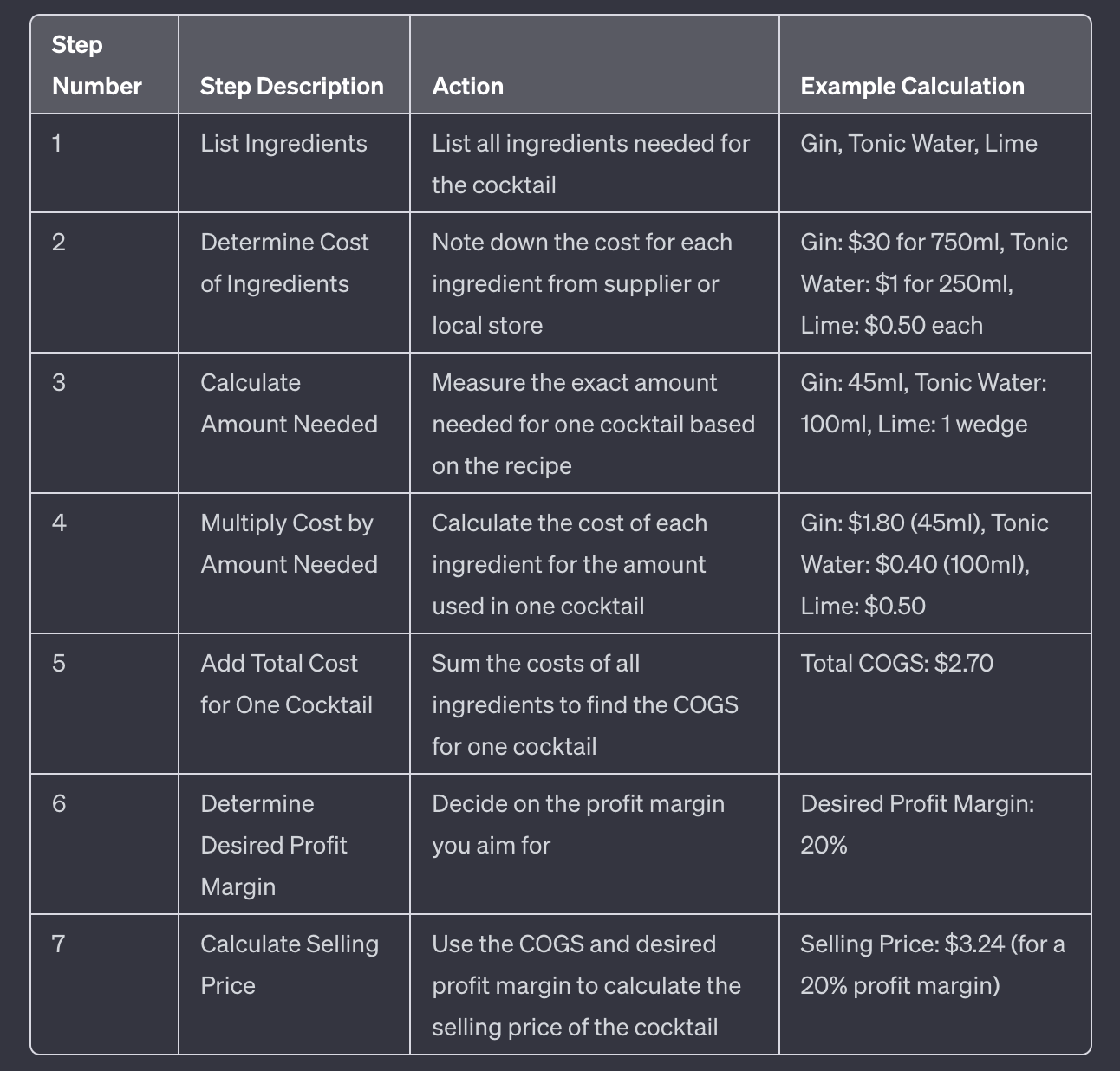How to Calculate the True Cost of Your Cocktails: A Step-by-Step Guide
As a bartender, sommelier, or bar owner, it's essential to understand the true cost of the cocktails and wine you're serving to set profitable and competitive prices.
However, calculating the cost of cocktails and wine can be a complex process that involves considering the cost of each ingredient, the amount of waste, and the overhead expenses of your bar or restaurant.
In this post, we'll provide a step-by-step guide on how to accurately calculate the cost of your cocktails and wine, along with tips on how to set prices that will help you maximize your profits and provide value to your guests.
Whether you're a seasoned bartender, sommelier, or just starting out in the industry, this guide will give you the tools to run a successful bar or restaurant and serve great cocktails and wine to your guests.
Here are the steps to calculate the cost of a cocktail
List all the ingredients required to make the cocktail, including the type and brand of alcohol, mixers, garnishes, etc.
Determine the cost of each ingredient. This will involve checking the prices of the various components at your supplier or local store. Be sure to include the cost of any perishable items that must be replaced regularly, such as fresh fruit or herbs.
Calculate the amount of each ingredient needed to make one cocktail. This will depend on your recipe, so be sure to measure accurately.
Multiply the cost of each ingredient by the amount needed to make one cocktail. For example, if the recipe requires 45 ml of gin, and a bottle of gin costs $30 for 750 ml, then the cost of 45 ml of gin is $1.80
To find the cost of 45 ml of gin, we divide the cost of a 750 ml bottle of gin by the total number of milliliters in the bottle and then multiply that result by the amount of gin required for the cocktail. In this case, the calculation is as follows:
Cost per ml of gin = $30 / 750 ml = $0.04 per ml
Cost of 45 ml of gin = $0.04 per ml x 45 ml = $1.80
Add up the total cost of all the ingredients needed to make one cocktail. This will give you the cost of goods sold (COGS) for the cocktail.
Determine your desired profit margin. This will depend on your business goals and the market you are operating in. Generally, you will want to aim for a profit margin of at least 20% to cover your overheads and make a profit.
Calculate the selling price of the cocktail. To do this, divide the COGS by your desired profit margin percentage and add the result to the COGS. For example, if the COGS for a cocktail is $5 and you want to make a 20% profit, you would divide $5 by 0.2 (20%) to get $25. Then, you would add $25 to $5 to get a selling price of $30.
By following these steps, you can accurately calculate the cost of your cocktails using ML and set a selling price that will help you achieve your business goals.
Example Cocktail Cost
List the ingredients and their quantities:
60 mL Rye Whiskey
30 mL Sweet Vermouth
2 dashes Angostura Bitters
1 Maraschino cherry (for garnish)
Determine the cost of each ingredient: To calculate the cost of each ingredient, find the price of the bottles or packages they come in and then divide the price by the total quantity of the product. For example:
Rye Whiskey: A 750 mL bottle costs $30. Price per mL = $30/750 mL = $0.04/mL
Sweet Vermouth: A 1L bottle costs $20. Price per mL = $20/1000 mL = $0.02/mL
Angostura Bitters: A 100 mL bottle costs $10. Price per mL = $10/100 mL = $0.10/mL
Maraschino cherries: A jar of 20 cherries costs $5. Price per cherry = $5/20 cherries = $0.25/cherry
Calculate the cost of each ingredient in the cocktail: Multiply the price per unit of each ingredient by the quantity required for the cocktail.
Rye Whiskey: $0.04/mL x 60 mL = $2.40
Sweet Vermouth: $0.02/mL x 30 mL = $0.60
Angostura Bitters: $0.10/mL x 2 dashes (approximately 2 mL) = $0.20
Maraschino cherry: $0.25/cherry x 1 cherry = $0.25
Add the costs of each ingredient to find the total cost of the cocktail:
$2.40 (Rye Whiskey) + $0.60 (Sweet Vermouth) + $0.20 (Angostura Bitters) + $0.25 (Maraschino cherry) = $3.45
So, the estimated cost of a Manhattan cocktail in this example is $3.45. Please note that these costs are hypothetical and may not reflect the actual costs in your area.
Pricing
When determining the price of a cocktail to be sold in a bar or restaurant, you'll want to consider additional factors such as labor, overhead, and desired profit margin. A general rule of thumb is to multiply the cost of the ingredients by a markup factor of 3 to 5, depending on your desired profit margin and the specific circumstances of your establishment.
Using the example of the Manhattan cocktail with an estimated cost of $3.45, you could apply a markup factor to find the selling price:
Low-end markup (3x): $3.45 * 3 = $10.35
High-end markup (5x): $3.45 * 5 = $17.25
The price range for this Manhattan cocktail could be between $10.35 and $17.25, depending on the desired profit margin and other factors such as location, target market, and ambiance.
Remember that these are just guidelines, and you should consider the specifics of your establishment and the local market when setting prices.
Cost percentage
Cost percentage, also known as pour cost or beverage cost percentage, is a key metric used in the bar and restaurant industry to measure the profitability of alcoholic beverages. It is calculated by dividing the cost of the ingredients used to make a drink by the selling price of the drink.
Cost percentage helps businesses understand how much of their revenue goes towards covering the cost of the drink ingredients and how much is left to cover other expenses and generate profit.
Here's an example to illustrate the concept of cost percentage:
Let's assume we have a cocktail with the following cost and selling price:
Cost of ingredients: $3.45
Selling price: $12.00
Now, we'll calculate the cost percentage:
Cost percentage = (Cost of ingredients / Selling price) * 100
Cost percentage = ($3.45 / $12.00) * 100 = 28.75%
In this example, the cost percentage for the cocktail is 28.75%. This means that 28.75% of the selling price covers the cost of the ingredients, while the remaining 71.25% can be used to cover other expenses (such as labor, rent, and utilities) and contribute to the business's profit.
A lower cost percentage generally indicates a higher profit margin for the drink, whereas a higher cost percentage means a lower profit margin. Bars and restaurants must monitor their cost percentages and adjust pricing or ingredient costs to balance profitability and competitive pricing.
Cocktail Codex: Fundamentals, Formulas, Evolutions
From the authors of the bestselling and genre-defining cocktail book Death & Co, Cocktail Codex is a comprehensive primer on the craft of mixing drinks that employs the authors’ unique “root cocktails” approach to give drink-makers of every level the tools to understand, execute, and improvise both classic and original cocktails.
In conclusion, understanding the cost of ingredients and cost percentage is crucial for businesses in the bar and restaurant industry to price their cocktails effectively and manage profitability. Establishments can set appropriate selling prices by calculating the cost of ingredients for a drink, such as a Manhattan cocktail, and determining the desired markup.
Additionally, evaluating cost percentages helps businesses balance covering expenses, generating profits, and staying competitive in the market.
Regularly monitoring and adjusting pricing and ingredient costs, as well as keeping an eye on cost percentages, are essential practices for the long-term success of any bar or restaurant.





